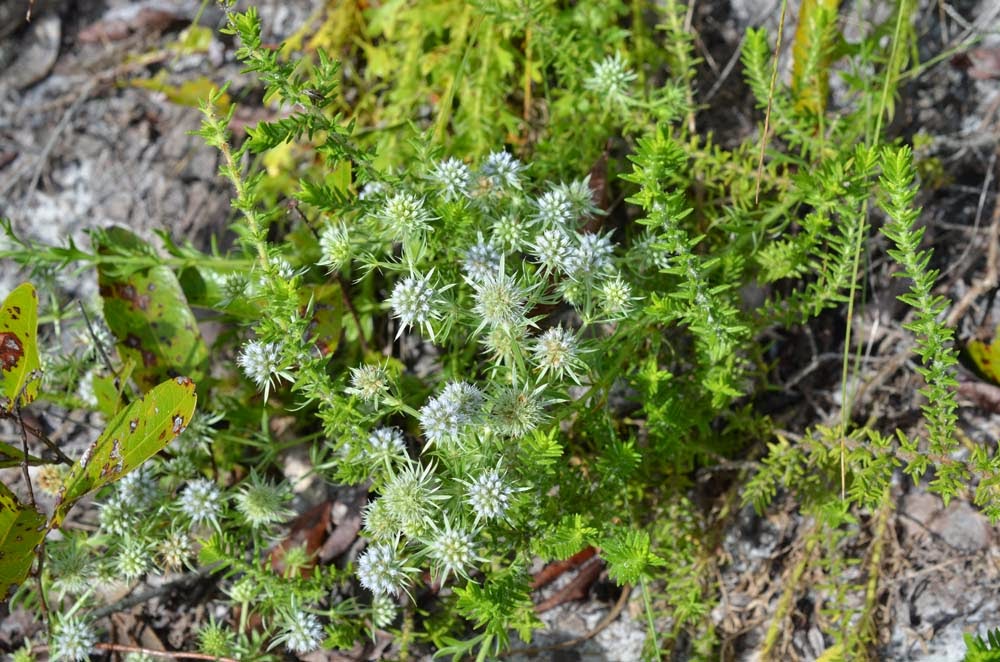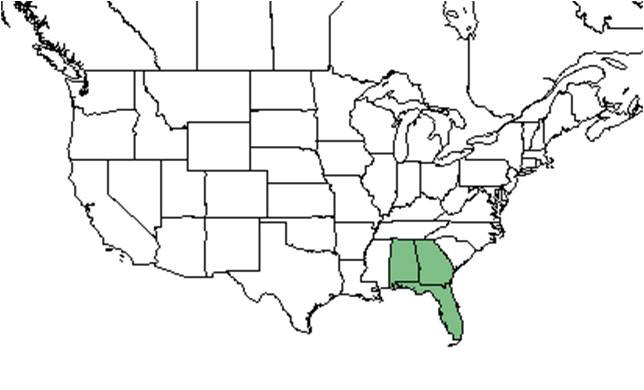Difference between revisions of "Eryngium aromaticum"
| Line 37: | Line 37: | ||
===Phenology=== <!--Timing off flowering, fruiting, seed dispersal, and environmental triggers. Cite PanFlora website if appropriate: http://www.gilnelson.com/PanFlora/ --> | ===Phenology=== <!--Timing off flowering, fruiting, seed dispersal, and environmental triggers. Cite PanFlora website if appropriate: http://www.gilnelson.com/PanFlora/ --> | ||
It produces thistle-shaped flowers arranged in umbels and achene fruit<ref name="Hortipedia"/>. | It produces thistle-shaped flowers arranged in umbels and achene fruit<ref name="Hortipedia"/>. | ||
| − | + | ===Seed dispersal=== | |
| − | + | ===Seed bank and germination=== | |
| − | + | ===Fire ecology=== <!--Fire tolerance, fire dependence, adaptive fire responses--> | |
| + | |||
===Pollination=== | ===Pollination=== | ||
The following Hymenoptera families and species were observed visiting flowers of ''Eryngium aromaticum'' at Archbold Biological Station (Deyrup 2015): | The following Hymenoptera families and species were observed visiting flowers of ''Eryngium aromaticum'' at Archbold Biological Station (Deyrup 2015): | ||
Revision as of 19:01, 23 February 2016
| Eryngium aromaticum | |
|---|---|

| |
| Photo by Wayne Matchett, SpaceCoastWildflowers.com | |
| Scientific classification | |
| Kingdom: | Plantae |
| Division: | Magnoliophyta - Flowering plants |
| Class: | Magnoliopsida - Dicotyledons |
| Order: | Apiales |
| Family: | Apiaceae ⁄ Umbelliferae |
| Genus: | Eryngium |
| Species: | E. aromaticum |
| Binomial name | |
| Eryngium aromaticum Baldw. | |

| |
| Natural range of Eryngium aromaticum from USDA NRCS Plants Database. | |
Common name: Fragrant eryngo
Contents
Description
E. aromaticum is a low growing, perennial herb that can be found as a basal rosette of slightly spiny, deeply dissected leaves through out most of the year. It has a carrot like taproot[1]. Leaves are simple and alternate[2].
Distribution
It is found throughout the peninsula and panhandle of Florida, along with parts of Georgia and Alabama[1].
Ecology
Habitat
It can be found in well drained upland habitats[1].
Occurs in loamy sand and peaty sand type habitats such as scrub, sand ridges, sandhills, and flatwoods. It has also been seen in human disturbed areas such as powerline corridors and disturbed slash pine forests (FSU Herbarium).
Associated species includes Agalinis plukenetii, Liatris provincialis, Chrysopsis gossypina, C. linearifolia, Polygonella gracile, P. polygoma, P. fimbriata, Aristida stricta, Pinus clausa, Pinus palustris, Quercus virginiana, Quercus laevis, and Serenoa repens (FSU Herbarium).
Phenology
It produces thistle-shaped flowers arranged in umbels and achene fruit[2].
Seed dispersal
Seed bank and germination
Fire ecology
Pollination
The following Hymenoptera families and species were observed visiting flowers of Eryngium aromaticum at Archbold Biological Station (Deyrup 2015):
Halictidae: Lasioglossum placidensis
Sphecidae: Tachysphex similis
Vespidae: Stenodynerus fundatiformis
Use by animals
Used as larval food by the Eastern black swallowtail butterfly[1].
Photo Gallery
References and notes
Deyrup, M.A. and N.D. 2015. Database of observations of Hymenoptera visitations to flowers of plants on Archbold Biological Station, Florida, USA.
- ↑ 1.0 1.1 1.2 1.3 [Native Florida Wildflowers]Accessed: December 7, 2015
- ↑ 2.0 2.1 [Hortipedia]Accessed: December 7, 2015